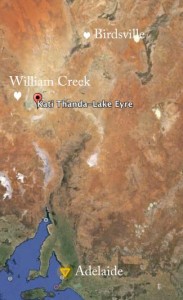 It’s day three of our journey to see Lake Eyre in flood. If you missed day 1 you’ll find it here, and day 2 is here. Today we leave Marree and travel along the Oodnadatta track to William Creek, where we’ll catch a plane.
It’s day three of our journey to see Lake Eyre in flood. If you missed day 1 you’ll find it here, and day 2 is here. Today we leave Marree and travel along the Oodnadatta track to William Creek, where we’ll catch a plane.
We’re really in the outback now, surrounded by barren plains with maybe a range of low hills on the horizon. It’s dry out here. Marree’s average annual rainfall is 160mm (6.3″). The vegetation is tough. There’s a lot of salt bush, and plants with leathery, greyish leaves. But there’s water, if you know where to look. Australia is host to the largest artesian basin in the world, and the road we’re following is there because it follows the water. Many towns up here have ‘wet’ words like creek or well in their names, places where water can be found. We stop in a particularly desolate area to look at the mound springs – places where the mineral-filled water bubbles up to the surface. Over thousands of years the minerals were deposited and the mounds built up. You can see from the pictures that around such springs the ground is lush with plant life. These springs have had to be protected from cattle, which trample the edges and muddy the flow.
Maybe they need to be protected from people, too. The settlers didn’t understand this country. Read the story on the information board and you’ll see what I mean. The aboriginal people called these places home, and they looked after them. Water, after all, is life.




But it’s not just humans who need water. We crossed a creek full with recent rain. It teemed with little fingerlings all fighting for a chance to get to lake Eyre. And surrounding this crossing were hundreds of silver gulls. The nearest coast is at Port Augusta, around 450km away. How the gulls knew the water and the fish were here is a mystery.


We arrived at William Creek (population 12) just before lunch, served (of course) in the pub. The owner, Trevor Wright, basically owns the town but he doesn’t like to be called king. He reckons he’s more of a benevolent dictator. He’s a big man with a shock of white hair and he operates the planes we’ll use over Lake Eyre. He likes to talk, too. One of his pilots came in to give him a hurry up call. The planes and the pilots were waiting.


 Six of us (including the pilot) crammed into a Cessna 210. I was in the last of 3 rows of seats and I won’t pretend it was comfy. The outside temperature was in the late 30’s and the cabin wasn’t air conditioned. We took along bottled water and frozen wet towels to keep us cool. I found the best way to avoid dwelling on discomfort was to watch what was going on below. It’s 450km as the crow flies from William Creek to Birdsville – and a bit more when you’re sight seeing. The journey took about two and a half hours and I don’t mind admitting I was pleased to stagger out of the plane at the other end.
Six of us (including the pilot) crammed into a Cessna 210. I was in the last of 3 rows of seats and I won’t pretend it was comfy. The outside temperature was in the late 30’s and the cabin wasn’t air conditioned. We took along bottled water and frozen wet towels to keep us cool. I found the best way to avoid dwelling on discomfort was to watch what was going on below. It’s 450km as the crow flies from William Creek to Birdsville – and a bit more when you’re sight seeing. The journey took about two and a half hours and I don’t mind admitting I was pleased to stagger out of the plane at the other end.
The following day we did it all again, flying from Birdsville back to Marree, where our driver picked us up. There’s a lot to say about Birdsville, but I’ll do that in another post. For now, let’s take a look at Kati Thanda-Lake Eyre.












4 Responses